A Framework for an Indoor Safety Management System Based on Digital Twin
Abstract
:1. Introduction
2. Literature Review
2.1. Artificial Intelligence of Things (AIoT)
2.2. Dynamic BIM
2.3. DTs
2.4. Research Gaps and Novelty
3. Materials and Methods
3.1. Concept of ISMS Integrating with DT Model
3.2. Methodology and System Framework
3.3. Establishment of DTM for Indoor Safety
3.3.1. Information Needed to Characterise DTM
3.3.2. Processing of BIM Model
3.3.3. Construction of IoT Structure
3.4. SVM for Intelligent Classification and Level Assessment of Danger
4. Case Study
4.1. Case Background and Scenario Simulation
4.2. Implementation Process and Effect of Experiment
4.2.1. Processing of BIM Model
4.2.2. Terminal Layout
4.2.3. Danger Simulation and Data Acquisition
4.2.4. Division Effect of Danger Types and Levels
4.2.5. Effects of Danger Alarm and Position with Scene and Handling Suggestions
5. Discussion and Conclusions
Author Contributions
Funding
Acknowledgments
Conflicts of Interest
References
- Sengan, S.; Subramaniyaswamy, V.; Nair, S.K.; Indragandhi, V.; Manikandan, J.; Ravi, L. Enhancing cyber–physical systems with hybrid smart city cyber security architecture for secure public data-smart network. Sustain. Cities. Soc. 2020, 112, 724–737. [Google Scholar]
- Jia, M.; Komeily, A.; Wang, Y.; Srinivasan, R.S. Adopting Internet of Things for the development of smart buildings: A review of enabling technologies and applications. Autom. Constr. 2019, 101, 111–126. [Google Scholar] [CrossRef]
- Sung, W.; Hsiao, S. The application of thermal comfort control based on Smart House System of IoT. Measurement 2020, 149, 106997. [Google Scholar] [CrossRef]
- Michalec, A.; Hayes, E.T.; Longhurst, J. Building smart cities, the just way. A critical review of “smart” and “just” initiatives in Bristol, UK. Sustain. Cities. Soc. 2019, 47, 101510. [Google Scholar] [CrossRef]
- Laufs, J.; Borrion, H.; Bradford, B. Security and the smart city: A systematic review. Sustain. Cities. Soc. 2020, 55, 102023. [Google Scholar] [CrossRef]
- Al Dakheel, J.; Del Pero, C.; Aste, N.; Leonforte, F. Smart buildings features and key performance indicators: A review. Sustain. Cities. Soc. 2020, 61, 102328. [Google Scholar] [CrossRef]
- Gramhanssen, K.; Darby, S. “Home is where the smart is”? Evaluating smart home research and approaches against the concept of home. Energy Res. Soc. Sci. 2018, 37, 94–101. [Google Scholar] [CrossRef]
- Hsu, H.T.; Jong, G.J.; Chen, J.H.; Jhe, C.G. Improve IoT security system of smart-home by using support vector machine. In Proceedings of the 2019 IEEE 4th International Conference on Computer and Communication Systems (ICCCS), Singapore, 23–25 February 2019; pp. 674–677. [Google Scholar]
- Peng, Y.; Li, S.W.; Hu, Z.Z. A self-learning dynamic path planning method for evacuation in large public buildings based on neural networks. Neurocomputing 2015, 365, 71–85. [Google Scholar] [CrossRef]
- Tao, F.; Liu, W.; Liu, J.; Liu, X.; Liu, Q.; Qu, T.; Hu, T.; Zhang, Z.; Xiang, F.; Xu, W.; et al. Digital twin and its potential application exploration. Comput. Intergr. Manuf. Syst. 2018, 24, 1–18. [Google Scholar]
- Tao, F.; Cheng, J.; Qi, Q.; Zhang, M.; Zhang, H.; Sui, F. Digital twin-driven product design, manufacturing and service with big data. Int. J. Adv. Manuf. Tech. 2018, 94, 3563–3576. [Google Scholar] [CrossRef]
- Zhang, H.; Ma, L.; Sun, J.; Lin, H.; Thurer, M. Digital Twin in Services and Industrial Product Service Systems: Review and Analysis. In Proceedings of the 11th CIRP Conference on Industrial Product-Service Systems, Zhuhai, China, 29–31 May 2019; pp. 57–60. [Google Scholar]
- Jones, D.M.; Snider, C.; Nassehi, A.; Yon, J.; Hicks, B.J. Characterising the Digital Twin: A systematic literature review. CIRP J. Manuf. Sci. Tec. 2020, 29, 36–52. [Google Scholar] [CrossRef]
- Papacharalampopoulos, A.; Giannoulis, C.; Stavropoulos, P.; Mourtzis, D. A Digital Twin for Automated Root-Cause Search of Production Alarms Based on KPIs Aggregated from IoT. Appl. Sci. 2020, 10, 2377. [Google Scholar] [CrossRef] [Green Version]
- Papacharalampopoulos, A.; Stavropoulos, P. Towards a digital twin for thermal processes: Control-centric approach. Procedia CIRP 2019, 86, 110–115. [Google Scholar] [CrossRef]
- Athanasopoulou, L.; Papacharalampopoulos, A.; Stavropoulos, P. Context awareness system in the use phase of a smart mobility platform: A vision system for a light-weight approach. In Proceedings of the 13th CIRP Conference on Intelligent Computation in Manufacturing Engineering, Gulf of Naples, Italy, 17–19 July 2019; pp. 560–564. [Google Scholar]
- Liu, Z.; Bai, W.; Du, X.; Zhang, A.; Xing, Z.; Jiang, A. Digital Twin-based Safety Evaluation of Prestressed Steel Structure. Adv. Civ. Eng. 2020. [Google Scholar] [CrossRef]
- Qiuchen, L.V.; Parlikad, A.K.; Woodall, P.; Ranasinghe, G.D.; Heaton, J. Developing a dynamic digital twin at a building level: Using Cambridge campus as case study. In Proceedings of the International Conference on Smart Infrastructure and Construction (ICSIC), Cambridge, UK, 8–10 July 2019; pp. 67–75. [Google Scholar]
- Xu, D.L.; He, W.; Li, S. Internet of things in industries: A survey. IEEE Trans. Ind. Inf. 2014, 10, 2233–2243. [Google Scholar] [CrossRef]
- Kochovski, P.; Stankovski, V. Supporting smart construction with dependable edge computing infrastructures and applications. Autom. Constr. 2018, 85, 182–192. [Google Scholar] [CrossRef]
- Li, N.; Becerikgerber, B.; Krishnamachari, B.; Soibelman, L. A BIM centered indoor localization algorithm to support building fire emergency response operations. Automat. Construct. 2014, 42, 78–89. [Google Scholar] [CrossRef]
- Cheng, M.; Chiu, K.; Hsieh, Y.; Yang, I.; Chou, J.; Wu, Y. BIM integrated smart monitoring technique for building fire prevention and disaster relief. Autom. Constr. 2017, 84, 14–30. [Google Scholar] [CrossRef]
- Huang, F.; Liao, Z.; Wang, T.; Chen, Q.; Wu, T.; Chang, C. Intelligent and Disaster Prevention Hard Hat Based on AIOT and Speeches Recognition. In Proceedings of the 2019 International Conference on Machine Learning and Cybernetics (ICMLC), Kobe, Japan, 7–10 July 2019; pp. 1–5. [Google Scholar]
- AlHajri, M.I.; Ali, N.T.; Shubair, R.M. Classification of indoor environments for IoT applications: A machine learning approach. IEEE Antenn. Wirel. Pr. 2018, 17, 2164–2168. [Google Scholar] [CrossRef]
- Li, W.; Hu, Z.; Pei, Z.; Li, S.; Chan, P.W. BIM-based integrated delivery technologies for intelligent MEP management in the operation and maintenance phase. Adv. Eng. Softw. 2018, 115, 1–16. [Google Scholar]
- Tang, S.; Shelden, D.; Eastman, C.M.; Pishdadbozorgi, P.; Gao, X. A review of building information modeling (BIM) and the internet of things (IoT) devices integration: Present status and future trends. Autom. Constr. 2019, 101, 127–139. [Google Scholar] [CrossRef]
- Zhang, J.; Guo, J.; Xiong, H.; Liu, X.; Zhang, D. A Framework for an Intelligent and Personalized Fire Evacuation Management System. Sensors 2019, 19, 3128. [Google Scholar] [CrossRef] [PubMed] [Green Version]
- Chen, X.S.; Liu, C.C.; Wu, I.C. A BIM-based visualization and warning system for fire rescue. Ad. Eng. Inf. 2018, 37, 42–53. [Google Scholar] [CrossRef]
- Wu, I.; Liu, C. A Visual and Persuasive Energy Conservation System Based on BIM and IoT Technology. Sensors 2019, 20, 139. [Google Scholar] [CrossRef] [Green Version]
- Zhao, L.; Liu, Z.; Mbachu, J. Development of Intelligent Prefabs Using IoT Technology to Improve the Performance of Prefabricated Construction Projects. Sensors 2019, 19, 4131. [Google Scholar] [CrossRef] [PubMed] [Green Version]
- Cheng, J.C.; Chen, W.; Chen, K.; Wang, Q. Data-driven predictive maintenance planning framework for MEP components based on BIM and IoT using machine learning algorithms. Autom. Constr. 2020, 112, 103087. [Google Scholar] [CrossRef]
- Negri, E.; Fumagalli, L.; Macchi, M. A review of the roles of digital twin in CPS-based production systems. In Proceedings of the 27th International Conference on Flexible Automation and Intelligent Manufacturing, FAIM2017, Modena, Italy, 27–30 June 2017; pp. 939–948. [Google Scholar]
- Liu, S.; Bao, J.; Lu, Y.; Li, J.; Lu, S.; Sun, X. Digital Twin Modeling Method Based on Biomimicry for Machining Aerospace Components. Available online: https://doi.org/10.1016/j.jmsy. (accessed on 14 April 2020).
- Li, W.; Rentemeister, M.; Badeda, J.; Jöst, D.; Schulte, D.; Sauer, D.U. Digital twin for battery systems: Cloud battery management system with online state-of-charge and state-of-health estimation. J. Energy Storage. 2020, 30, 101557. [Google Scholar] [CrossRef]
- Ge, S.; Zhang, F.; Wang, S.; Wang, Z. Digital Twin for Smart Coal Mining Workface: Technological Frame and Construction. Available online: https://doi.org/10.13225/j.cnki.jccs.ZN20.0327 (accessed on 9 June 2020).
- Coraddu, A.; Oneto, L.; Baldi, F.; Cipollini, F.; Atlar, M.; Savio, S. Data-driven ship digital twin for estimating the speed loss caused by the marine fouling. Ocean Eng. 2019, 186, 106063. [Google Scholar] [CrossRef]
- Kaewunruen, S.; Lian, Q. Digital twin aided sustainability-based lifecycle management for railway turnout systems. J. Clean. Prod. 2019, 228, 1537. [Google Scholar] [CrossRef]
- Tao, F.; Liu, W.; Zhang, M.; Hu, T.; Qi, Q.; Zhang, H.; Sui, F.; Wang, T.; Xu, H.; Huang, Z.; et al. Five dimension digital twin model and its ten applications. Comput. Intergr. Manuf. Syst. 2019, 25, 1–18. [Google Scholar]
- Liu, C.; Jiang, P.; Jiang, W. Web-based digital twin modeling and remote control of cyber-physical production systems. Robot. Comput. Integr. Manuf. 2020, 54, 101956. [Google Scholar] [CrossRef]
- Qi, Q.; Tao, F.; Hu, T.; Anwer, N.; Liu, A.; Wei, Y.; Wang, L.; Nee, A.Y.C. Enabling Technologies and Tools for Digital Twin. J. Manuf. Syst. Available online: https://doi.org/10.1016/j.jmsy.2019.10.001 (accessed on 29 October 2019).
- Boje, C.; Guerriero, A.; Kubicki, S.; Rezgui, Y. Towards a semantic Construction Digital Twin: Directions for future research. Autom. Constr. 2020, 114, 103179. [Google Scholar] [CrossRef]
- Fan, C.; Zhang, C.; Yahja, A.; Mostafavi, A. Disaster City Digital Twin: A Vision for Integrating Artificial and Human Intelligence for Disaster Management. Available online: https://doi.org/10.1016/j.ijinfomgt.2019.102049 (accessed on 27 December 2019).
- Greif, T.; Stein, N.; Flath, C.M. Peeking into the void: Digital twins for construction site logistics. Comput. Ind. 2020, 121, 103264. [Google Scholar] [CrossRef]
- Angjeliu, G.; Coronelli, D.; Cardani, G. Development of the simulation model for Digital Twin applications in historical masonry buildings: The integration between numerical and experimental reality. Comput. Struct. 2020, 238, 106282. [Google Scholar] [CrossRef]
- Zhang, J.; Shan, Y.; Huang, K. ISEE Smart Home (ISH): Smart video analysis for home security. Neurocomputing 2015, 149, 752–766. [Google Scholar] [CrossRef]
- Qian, Y.; Liang, Y.; Li, M.; Feng, G.; Shi, X. A resampling ensemble algorithm for classification of imbalance problems. Neurocomputing 2014, 143, 57–67. [Google Scholar] [CrossRef]
- Huang, C.L.; Wang, C.J. A GA-based feature selection and parameters optimization for support vector Machines. Expert Syst. Appl. 2006, 31, 231–240. [Google Scholar] [CrossRef]
- Cherkassky, V.; Ma, Y. Practical selection of SVM parameters and noise estimation for SVM regression. Neural Netw. 2004, 17, 113–126. [Google Scholar] [CrossRef] [Green Version]
- Keerthi, S.S.; Lin, C.J. Asymptotic behaviors of support vector machines with Gaussian kernel. Neural Comput. 2003, 15, 1667–1689. [Google Scholar] [CrossRef]
- Lin, H.T.; Lin, C.J. A study on sigmoid kernels for SVM and the training of non-PSD kernels by SMO-type methods. Neural Comput. 2003, 3, 1–32. [Google Scholar]
- Sankaranarayanan, S.; Mookherji, S. SVM-based traffic data classification for secured IoT-based road signaling system. Int. J. Intell. Inf. Technol. 2019, 15, 22–50. [Google Scholar] [CrossRef] [Green Version]


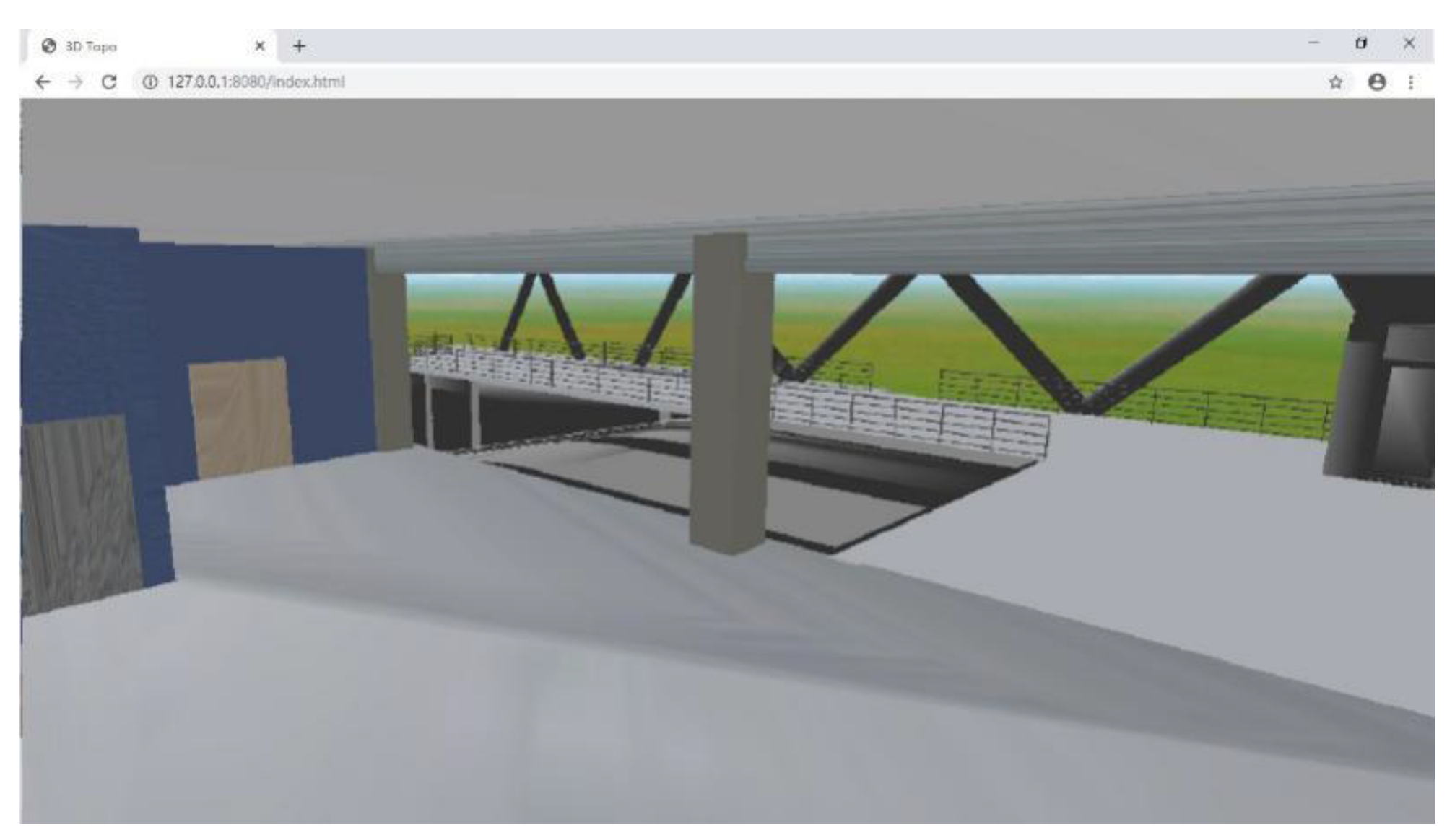
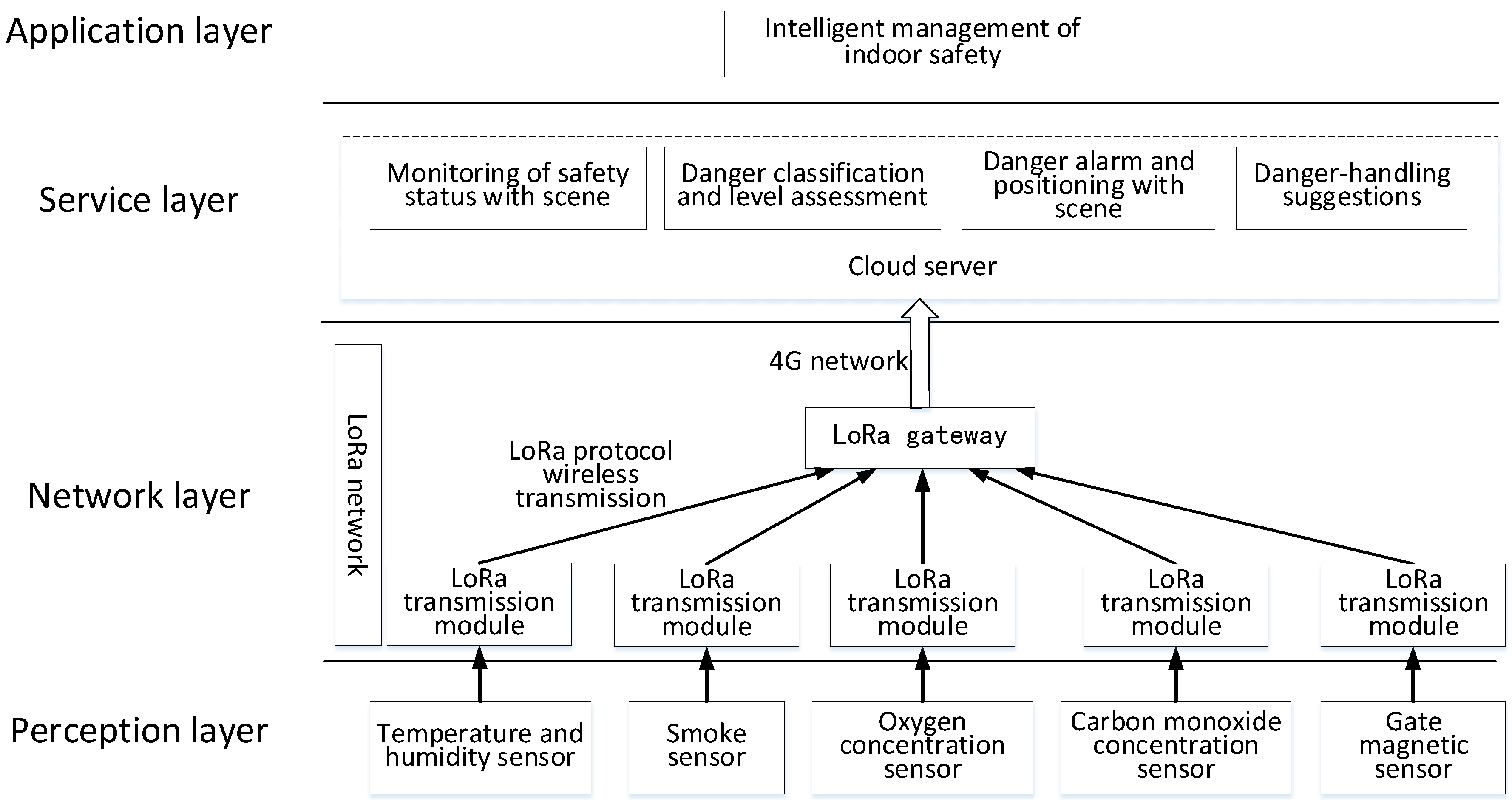



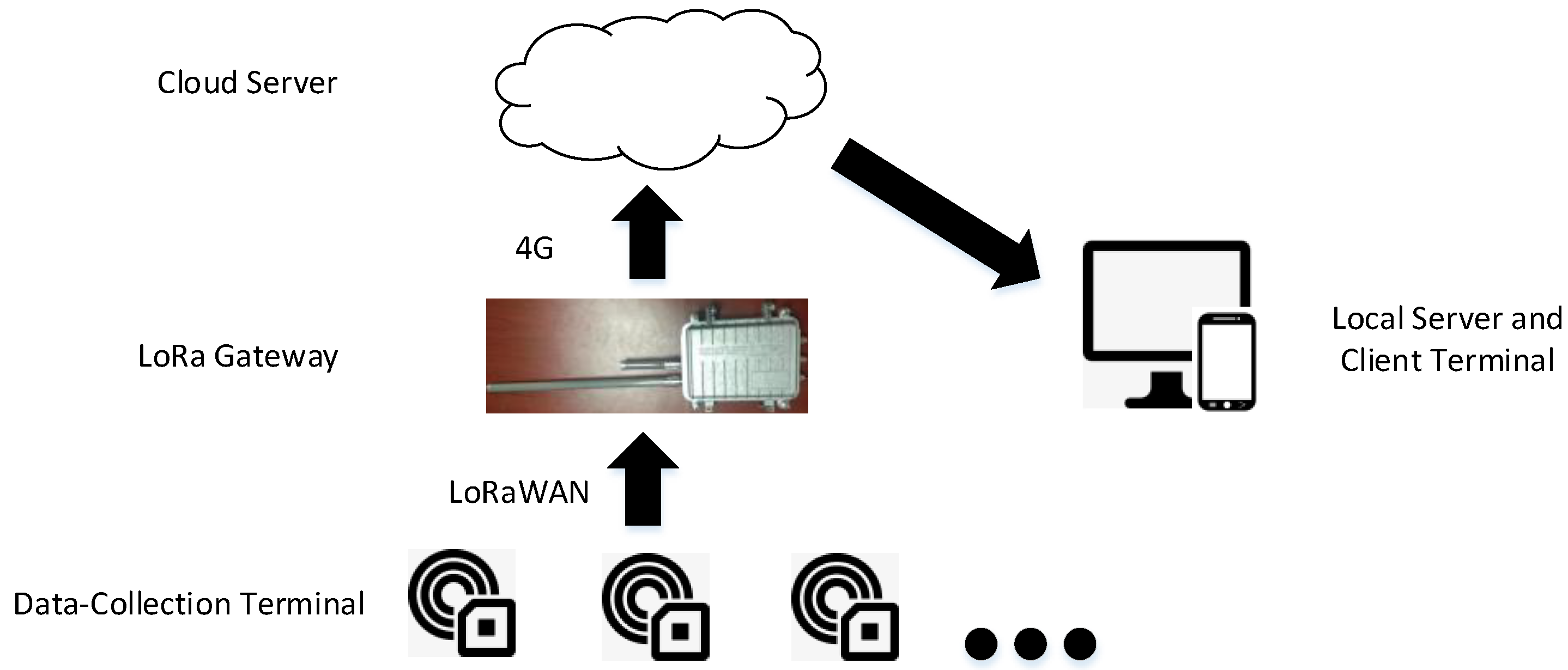


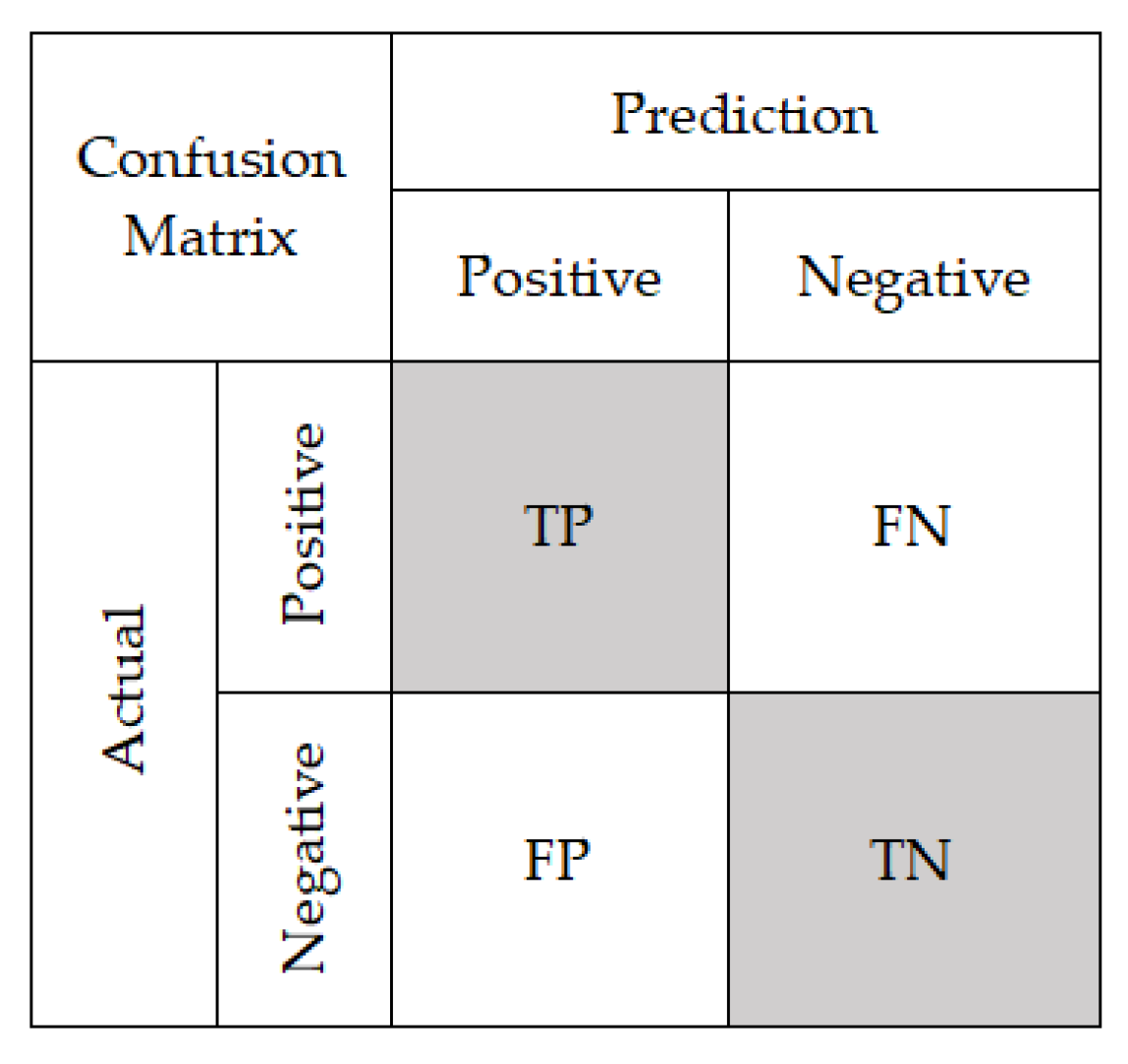
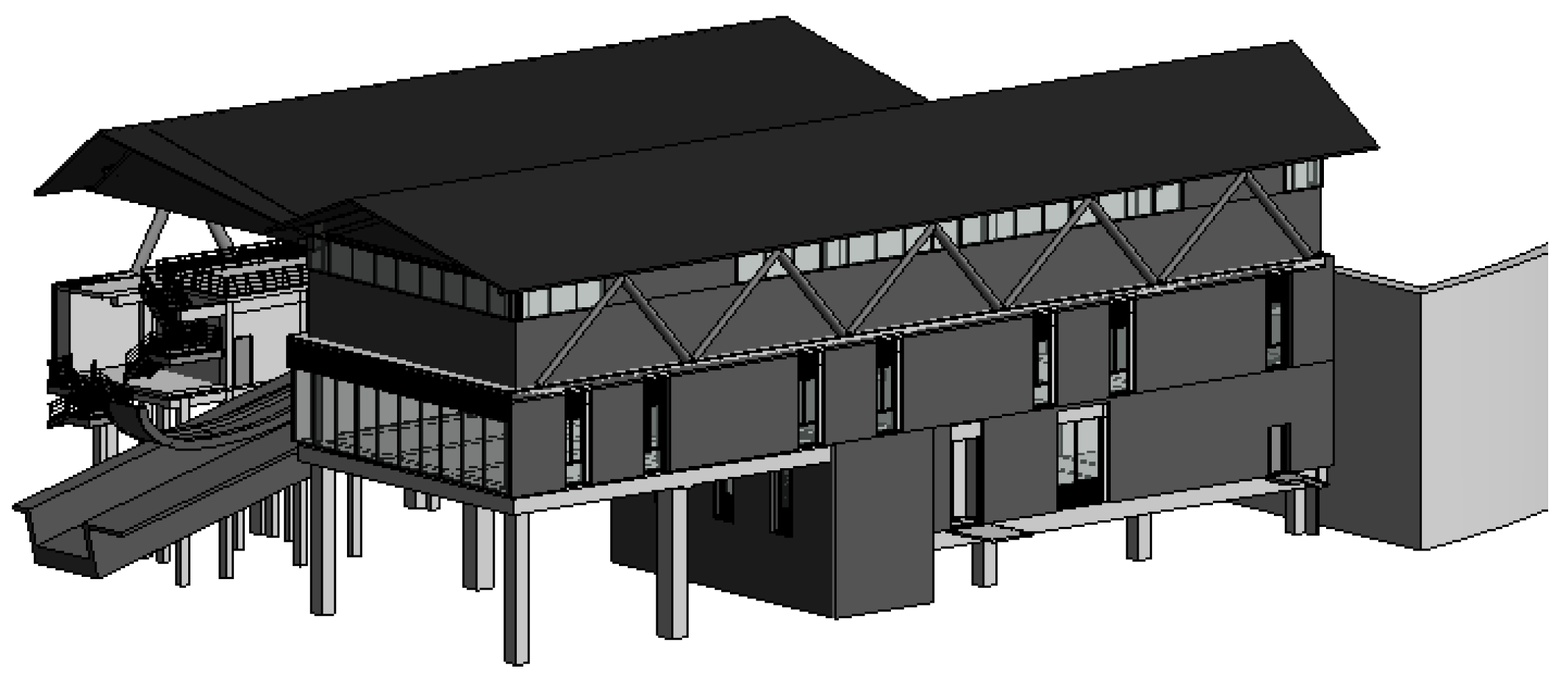
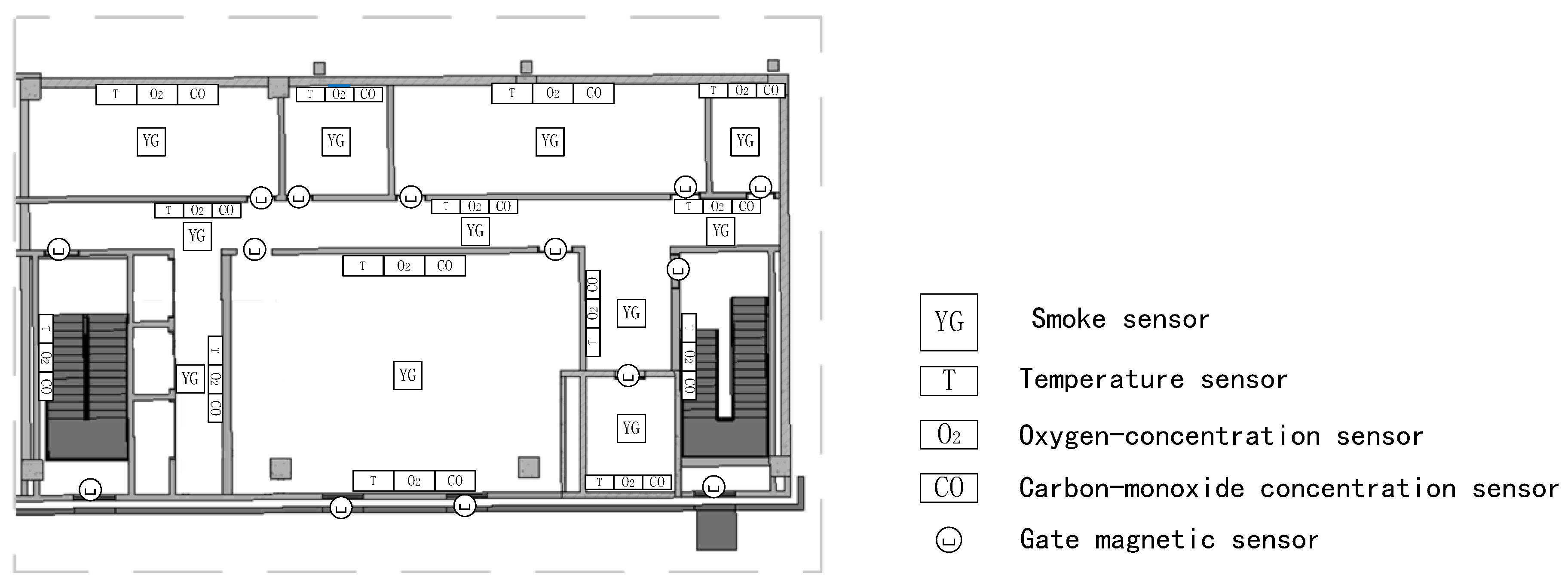

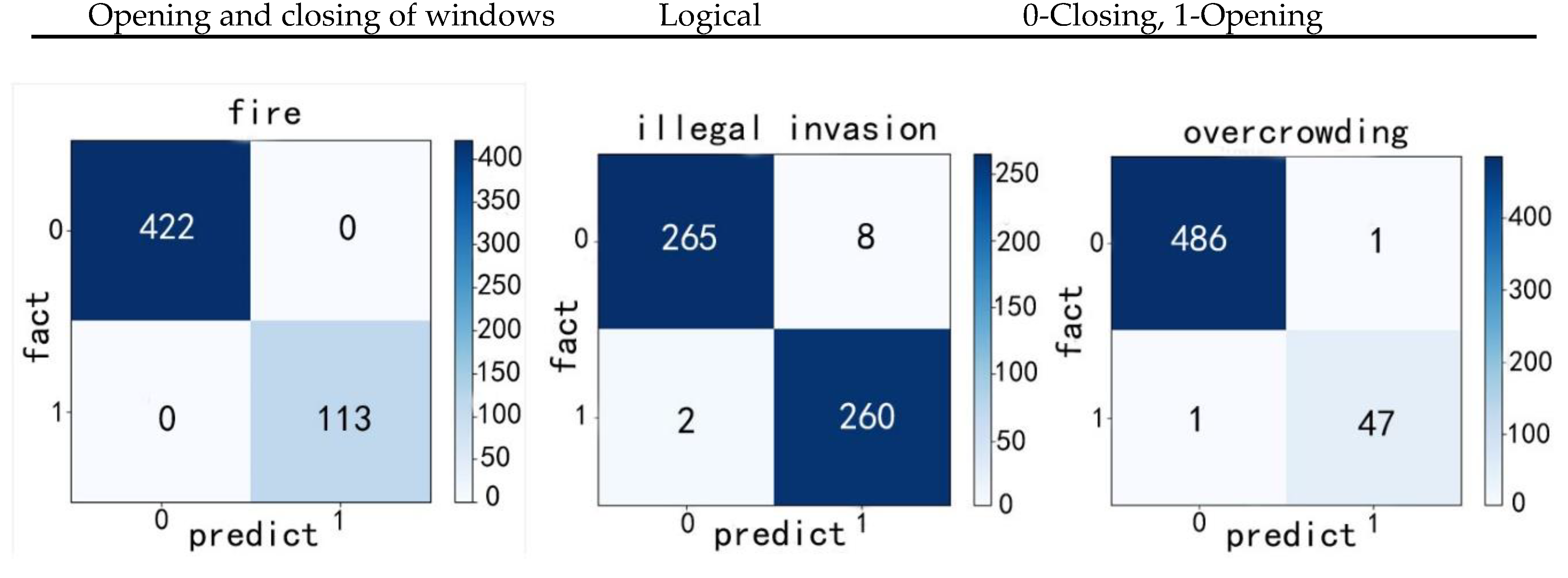
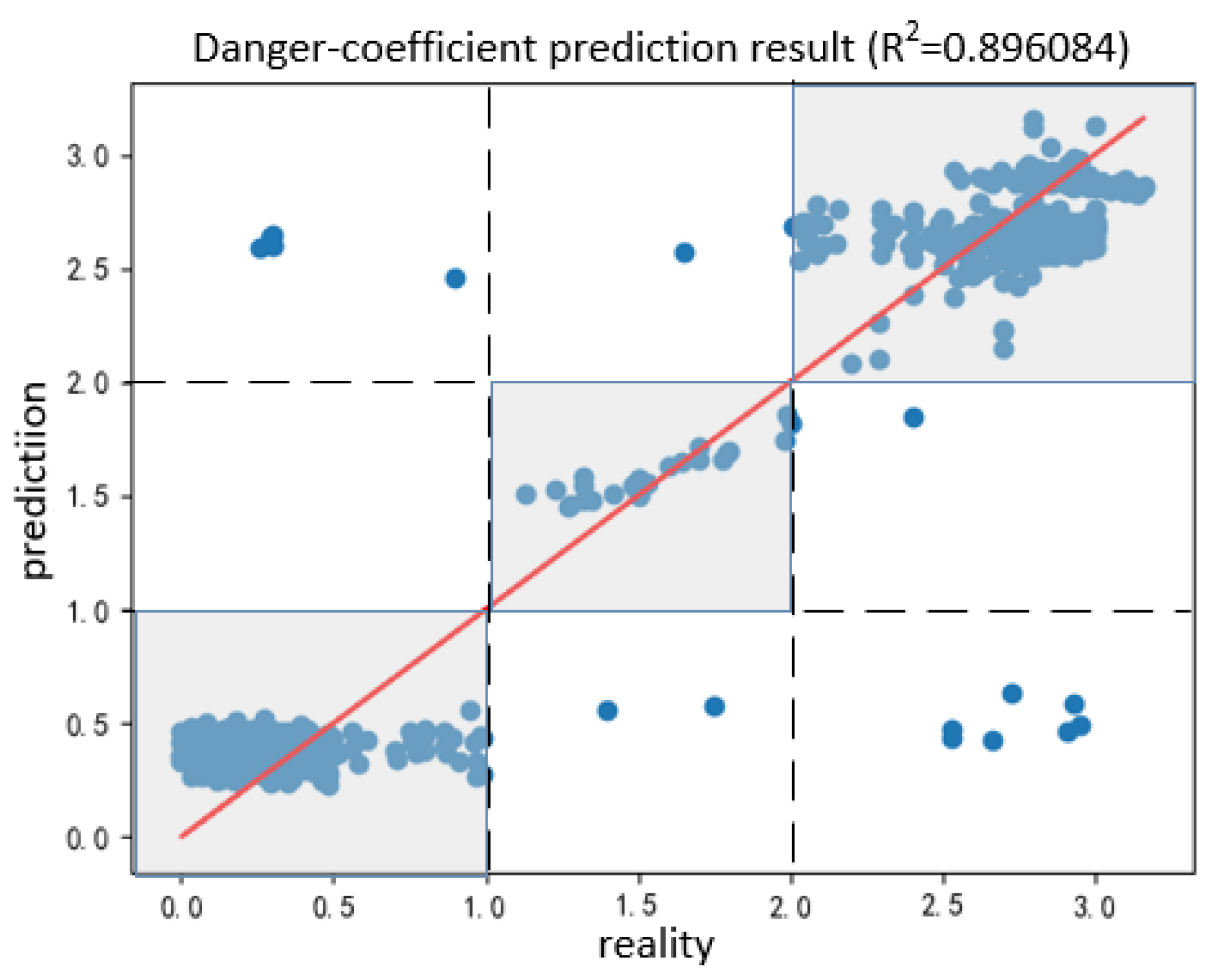

| Sensor | Range | Accuracy |
|---|---|---|
| Carbon-monoxide concentration sensor | 0–2000 ppm | 10 ppm |
| Oxygen-concentration sensor | 0%–30% | 0.1% |
| Temperature sensor | 0–70 °C | ±0.2 K (at 25 °C) |
| Smoke-concentration sensor | 100–5000 ppm | ±7% |
| Types | Illegal Invasion | Overcrowding | Fire | ||
|---|---|---|---|---|---|
| Suggestion | |||||
| Levels | |||||
| Safe | No suggestion. | No suggestion. | No suggestion. | ||
| Potentially dangerous | There is a risk of illegal invasion in a certain room, please pay attention to observe the room situation and eliminate potential danger in time. | The number of people in a room has reached x (x is the number of people), and there is a risk of overcrowding. Please pay attention to the gathering of people. | There is a fire risk in a room. Please pay attention to the situation of the room and eliminate the potential danger in time. | ||
| Dangerous | A certain room has been invaded, and a certain door and/or window opened abnormally. Please deal with it in time. | The number of people in a certain room has reached x, and the crowd is too dense. Please guide and evacuate. | Fire has broken out in a room. Please rescue immediately. | ||
| Category | Fire | Illegal Invasion | Overcrowding | Normal | Total | ||
|---|---|---|---|---|---|---|---|
| Number | |||||||
| Items | |||||||
| Samples collected | 566 | 567 | 241 | 63,426 | 64,800 | ||
| Samples used for SVM training and testing | 566 | 567 | 241 | 1300 | 2674 | ||
| Characteristic Variable | Data Type | Maximum | Minimum | Average | Mean-Squared Error |
|---|---|---|---|---|---|
| Numerical time | Numerical | 0.99 | 0 | 0.24 | 0.40 |
| Temperature (°C) | Numerical | 215 | 25 | 46.76 | 45.67 |
| Number of personnel | Numerical | 23 | 0 | 3.33 | 4.57 |
| Oxygen concentration (%) | Numerical | 23 | 20 | 21.52 | 1.11 |
| Carbon-monoxide concentration (ppm) | Numerical | 325 | 0 | 53.51 | 89.0 |
| Smoke concentration (ppm) | Numerical | 4957 | 0 | 462 | 1078 |
| Opening and closing of doors | Logical | 0-Closing, 1-Opening | |||
| Opening and closing of windows | Logical | 0-Closing, 1-Opening | |||
| Category | Fire | Illegal Invasion | Overcrowding | |
|---|---|---|---|---|
| Index | ||||
| Accuracy | 100% | 97.57% | 99.25% | |
| Precision | 100% | 98.15% | 97.07% | |
| Recall | 100% | 99.25% | 99.38% | |
| Characteristic Variable | Data Type | Numerical Value and Its Meaning |
|---|---|---|
| Whether illegal invasion occurs | Logical | 0-No, 1-Yes |
| Whether fire occurs | Logical | 0-No, 1-Yes |
| Whether overcrowding occurs | Logical | 0-No, 1-Yes |
© 2020 by the authors. Licensee MDPI, Basel, Switzerland. This article is an open access article distributed under the terms and conditions of the Creative Commons Attribution (CC BY) license (http://creativecommons.org/licenses/by/4.0/).
Share and Cite
Liu, Z.; Zhang, A.; Wang, W. A Framework for an Indoor Safety Management System Based on Digital Twin. Sensors 2020, 20, 5771. https://doi.org/10.3390/s20205771
Liu Z, Zhang A, Wang W. A Framework for an Indoor Safety Management System Based on Digital Twin. Sensors. 2020; 20(20):5771. https://doi.org/10.3390/s20205771
Chicago/Turabian StyleLiu, Zhansheng, Anshan Zhang, and Wensi Wang. 2020. "A Framework for an Indoor Safety Management System Based on Digital Twin" Sensors 20, no. 20: 5771. https://doi.org/10.3390/s20205771
APA StyleLiu, Z., Zhang, A., & Wang, W. (2020). A Framework for an Indoor Safety Management System Based on Digital Twin. Sensors, 20(20), 5771. https://doi.org/10.3390/s20205771






